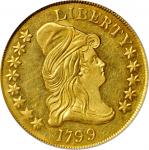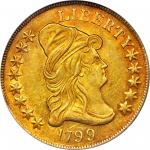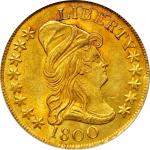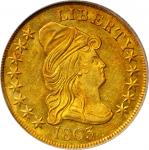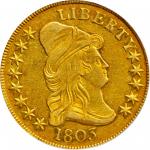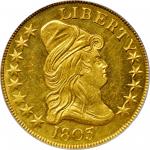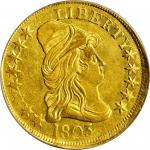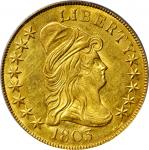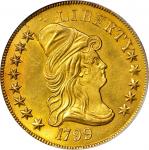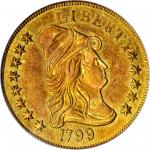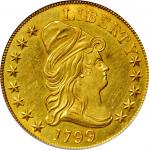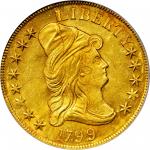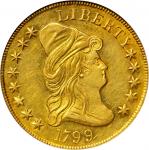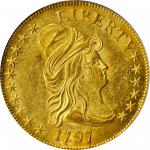1799 Capped Bust Right Eagle. BD-8, Taraszka-20. Rarity-5. Small Obverse Stars. MS-61 (PCGS).Type and Style: Type II: Capped Bust Right, Heraldic Eagle. Style VI: Head of 1795 with 13 small stars arranged eight left, five right; Reverse of 1799 with 13 small stars in the field below the clouds and a short, thick neck on the eagle. The head and eagle punches are attributed to hubs prepared by Robert Scot. Die Variety: BD-8, Taraszka-20, Breen 4-D, HBCC-3189. This variety represents the second of two uses of this obverse die and the only use of this reverse die. The obverse exhibits a pronounced slant to the right for the digits 17 in the date, the final digit 9 is close to the bust, and star 9 nearly touches the letter Y in LIBERTY below its right serif. On the reverse, stars 1 and 2 are repunched, one point of star 12 is joined to the tip of the eagles upper beak, star 13 touches the ribbon above the second letter U in UNUM, and the lowest arrow head is under the right half of the letter U in UNITED.Die State: BD Die State c/b. This is the only die state currently known for this variety, its scarcity making it unlikely that additional die states will be discovered. In fact, we know that the obverse only exists in State c in the 1799 BD-8 marriage, which was struck between die states of the 1799 BD-7 variety. There is crumbling within the denticles outside stars 1 and 2, as inherited from the 1799 BD-7 pairing, the die now developing cracks through stars 1 to 8 and through the letters TY in LIBERTY and stars 9 and 10. The fact that the latter crack does not extend through stars 11 to 13 suggests that this coin is one of the earlier impressions from the 1799 BD-8 pairing.Although only a single reverse die state is recognized for this variety, there are multiple stages of the break up of this die. On the present example, cracks are evident through the letters TATE in STATES, through the letters MER in AMERICA to the tip of the leaf below the letter I, through the letters ICA to the eagles talon, through the letter IC to the tip of the leaf below the corner of the A, from the border after the word AMERICA to the eagles tail, and from the border through the letter O in OF to a cloud. Additionally, there are jagged die breaks at the base of the letter D in UNITED and within the letter C in AMERICA. Die clash has resulted in damage to many of the horizontal lines in the shield. Wider damage from this clashing eventually resulted in additional cracks (not evident here) that would develop before the Mint retired this die, such as at the letter F in OF and involving stars 4, 9 and the eagles head.Estimated Mintage for the Issue: The conventionally accepted mintage has been 37,449 coins for the 1799 Capped Bust Right eagle issue, based on Walter Breens assumption that all of the coins delivered between May 14, 1799, and September 4, 1800, were from 1799-dated dies. After careful study, Dannreuther provides a revised range of 31,750 to 46,250 pieces produced, the lower estimate allowing for the possibility that some 1797 BD-3 and/or BD-4 coins were included in Breens 37,499-piece mintage, and the upper estimate allowing for the possibility that some 1799-dated eagles were also included in later deliveries.Estimated Mintage for the Variety: Dannreuther estimates that 2,500 to 3,500 examples were coined from the 1799 BD-8 dies.Estimated Surviving Population for the Variety: Only 45 to 55 coins are believed extant in all grades (per Dannreuther).Strike: This impressive early eagle is sharply to fully defined from a well centered strike.Surfaces: Here is a beautifully toned and wonderfully original example, with both sides exhibiting subtle pale rose peripheral highlights on otherwise bright medium gold surfaces. The luster is full and decidedly semi-prooflike, as evidenced by modest, yet appreciable reflectivity in the fields. Minimally marked and pleasingly smooth, this coin seems conservatively graded at the assigned level. A tiny, shallow planchet void on the eagles breast below the letter N in UNUM serves as a provenance marker.Commentary: As related above, all known examples of the 1799 BD-8 eagle were struck between die states of the 1799 BD-7 variety. For unknown reasons the Mint initially replaced the reverse die of the 1799 BD-7 pairing with the reverse die represented here, only to have that die break up and fail quickly, resulting in the BD-7 remarriage. The fact that the obverse of the present example is in a somewhat earlier state strongly suggests that the reverse die developed numerous extensive cracks early in the BD-8 press run. The early break up of this reverse die resulted in relatively few coins being struck, which in turn explains the scarcity of the 1799 BD-8 variety. A significant bidding opportunity for early gold variety specialists, this premium quality MS-61 example would also make a fine addition to an advanced type set.From the Anthony J. Taraszka Collection. Acquired from Jim McGuigan, March 1996. The plate coin for the die variety in the book United States Ten Dollar Gold Eagles: 1795-1804 by Anthony J. Taraszka.

